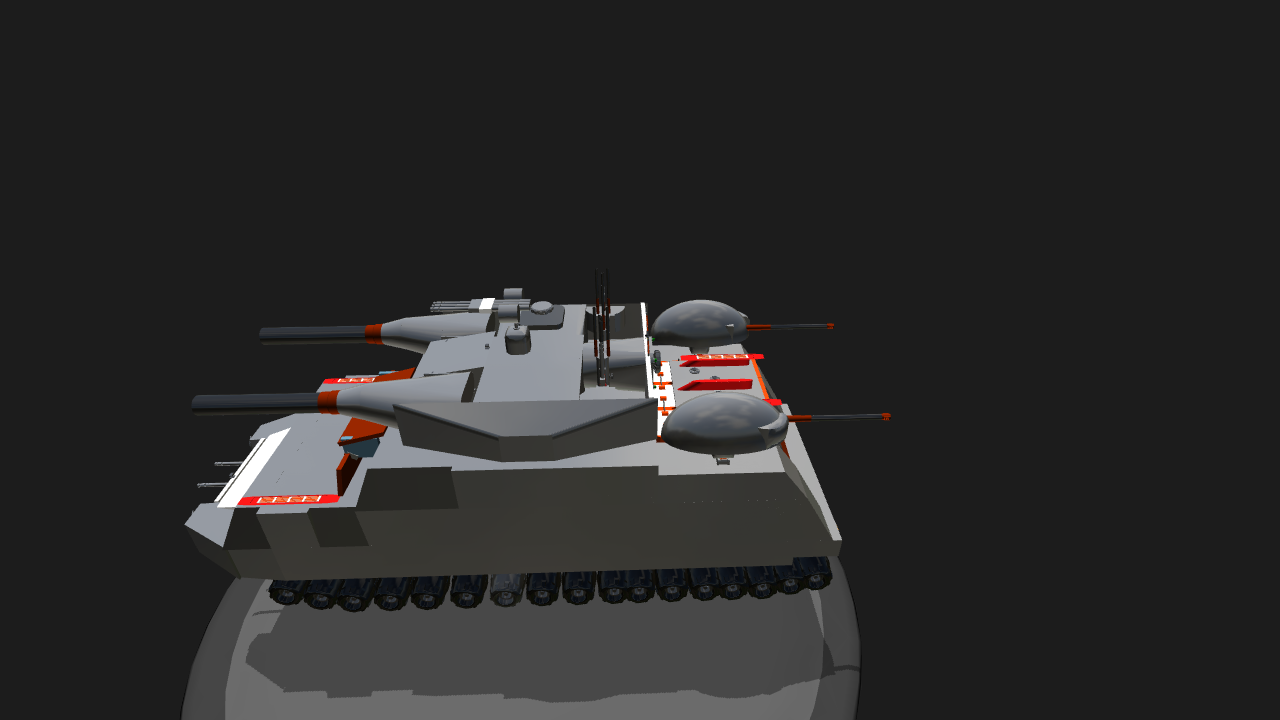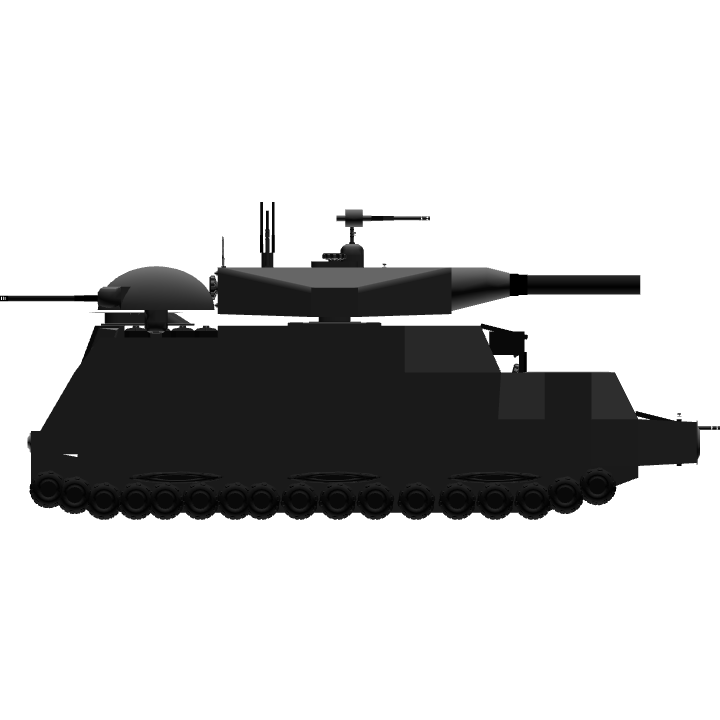Biggest tank ever designed approved by hitler himself, but tank was never put into practical use due to size. This is a smaller replica of the original tank but is as accurate as possible. This is my first time entering a competition.
Tank Historical information
The Landkreuzer P. 1000 "Ratte" (English: Land Cruiser P. 1000 "Rat") was a (possibly fanciful) design for a 1000-ton tank for use by Nazi Germany during World War II, that may have been proposed by Krupp director Edward Grotte in June 1942, who had already named it "Landkreuzer". Submitted designs and drawings of the vehicle went under the names OKH Auftrag Nr. 30404 and E-30404/1, which were presented in December 1942. The tank was planned to be 1000 tonnes, being far heavier than the Panzer VIII "Maus", the heaviest tank ever built (weighing 188 tonnes). The project gained the approval of Adolf Hitler, who had expressed interest in the development of the tank, but was cancelled by Minister of Armaments Albert Speer in early 1943.
Development
The development history of the Ratte originated with a 1941 strategic study of Soviet heavy tanks conducted by Krupp, the study also giving birth to the Panzer VIII Maus super-heavy tank.[1] The study led to a suggestion from Krupp's director (Grotte), a special officer for submarine construction, who, on 23 June 1942, proposed to Adolf Hitler a 1,000-tonne self-propelled gun which he named "Landkreuzer" ("Land Cruiser"). It consisted of a fully tracked chassis carrying one of the surplus main gun turrets left over from the planned refitting of the Scharnhorst-class battleships. To protect this immense economic investment, the hull of the vehicle was to carry armor up to 25 centimeters (9.8 in) thick, and several anti-aircraft guns were to be installed on the vehicle's engine deck to fend off Allied ground-attack aircraft.
Hitler became enamored with Grotte's concept and ordered Krupp to begin development of it in 1942. As of December 29, 1942 a few preliminary drawings had been completed, by which time the concept had been named "Ratte" ("Rat") by Hitler himself. These submitted designs went under the titles OKH Auftrag Nr. 30404 and E-30404/1.Albert Speer saw no reasonable use of the tank and canceled the project in 1943 before any prototype could be manufactured, although this did lead to the concept of the Landkreuzer P. 1500 Monster self-propelled siege gun, which would have been heavier than the Ratte.The general idea for such a big tank was best summed up by Heinz Guderian, saying that: "Hitler's fantasies sometimes shift into the gigantic".
Not all historians are convinced that the P.1000 even got as far as an outline design. Although it is generally accepted that Hitler asked for a feasibility study into a 1000-ton tank in 1942, there is much doubt around the specifics of the plan to use the 280-millimetre (11 in) guns or spare turrets from the battleship Gneisenau. The turrets alone weighed approximately 750 tons and required a five-storey structure to house the associated handling rooms and rotating machinery. Such weapons would also require separate magazines and shell rooms as well as handling machinery for the ammunition, all of which required space and power well beyond the scope of what would be possible in a 1000-ton tracked vehicle. Accordingly, some historians believe the P.1000 Ratte diagram to be either a hoax, or alternatively a speculative engineer's sketch made for personal amusement.
Description
The Ratte is known for its enormous proposed size: it would have weighed 1,000 tonnes, five times the weight of the Panzer VIII Maus. The divided weight of the Ratte included 300 tonnes of armament (the total weight of the guns themselves was 100 tonnes, so turret amour would have weighed 200 tonnes), 200 tonnes of armor and frame, and 100 tonnes of track and automotive components, while remaining weight would have been distributed to miscellaneous features. It was planned to be 35 m (115 ft) long (39 meters (128 ft) when including naval guns), 11 m (36 ft) high, and 14 m (46 ft) wide. This immense weight was to be distributed across the ground by six 1.2-meter (3 ft 11 in) wide and 21-meter (69 ft) long treads, together forming two composite treads with a width of 3.6 meters (11 ft 10 in) each. This would help stability and weight distribution, but the vehicle's sheer mass would have destroyed roads and rendered bridge crossings next to impossible. It was expected that its height, and its ground clearance of 2 m (6.6 ft), would have allowed it to ford most rivers with relative ease, thus eliminating the need for bridge crossings.
Planned propulsion was by two MAN V12Z32/44 24-cylinder marine diesel engines of 6,300 kW (8,400 hp) each (as used in U-boats) or eight Daimler-Benz MB 501 20-cylinder marine diesel engines of 1,500 kW (2,000 hp) each (as used in E-boats) to achieve the 12,000 kW (16,000 hp) needed to move the tank. The engines were to be provided with snorkels, also like those used by German submarines. The snorkels were designed to provide a way for oxygen to reach the engine, even during amphibious operations while passing through deep water.[3]
The Ratte's primary weapon would have been a dual 28 cm SK C/34 naval gun turret. This was the same turret that was used on the German battleship Gneisenau but modified by removing one of its three guns and its associated loading mechanism.[10] Removing the third gun allowed extra accommodation of ammunition, and reduced the total weight of the tank by 50 tonnes. The guns used for the Ratte would have fired ammunition developed for other naval guns. It also included armor-piercing rounds with 8.1 kg (18 lb) of explosive filler, and high-explosive rounds with 17.1 kg (38 lb) of explosive filler.[9]
Further armament was to consist of a 128 mm anti-tank gun of the type used in the Jagdtiger or Maus, two 15 mm Mauser MG 151/15 auto-cannons, and eight 20 mm Flak 38 anti-aircraft guns, probably with at least four of them as a Flakvierling quad mount.[2][7] The 128 mm anti-tank gun's precise location on the Ratte is a point of contention among historians, most believing that it would have been mounted within the primary turret, with some others thinking a smaller secondary turret at the rear of the Ratte more logical.[3] Some concept drawings exist to suggest a flexible mount on the glacis plate. The tank was to be provided with a vehicle bay that could hold two BMW R12 motorcycles for scouting, and several smaller storage rooms, a compact infirmary area, and a self-contained lavatory system.[3][10]
Issues
The large size and weight would have rendered the tank unable to cross bridges at the risk of collapsing them, and traveling on roads would soon destroy them. Though its top intended speed was 40 kilometers per hour (25 mph), its huge size and high visibility would have made it extremely vulnerable to aerial bombardment and artillery fire. Its great size would also have meant that once built the vehicle's strategic, operational, and tactical mobility would be entirely dependent on its own drivetrain, for there were no other realistic means of moving it from one firing position to another. No existing railway or train car could bear its weight and its width was too great for existing tunnels.[3]
TypeProject super-heavy tank
Place of originNazi Germany
Production history
Historical DesignerKrupp
Specifications
Mass1,000 tonnes (1,100 short tons; 980 long tons), estimated
Length35 m (115 ft) hull
39 m (128 ft) guns forwards
Width14 m (46 ft)
Height11 m (36 ft)
Crew20+, possibly as many as 41
Armor150–360 mm (5.9–14.2 in)
Main
armament2 × 280 mm 54.5 SK C/34
Secondary
armament1 × 128 mm KwK 44 L/55
8 × 20 mm Flak38
2 × 15 mm MG 151/15
Engine8 × Daimler-Benz MB501 20-cylinder marine diesel engines, or
2 × MAN V12Z32/44 24-cylinder marine diesel engines
12,000 to 13,000 kW (16,000 to 17,000 hp)
Ground clearance2 m (79 in)
Operational
range~190 kilometres (120 mi)
Maximum speed~40 km/h (25 mph)
Info from Wikipedia
(weapon Controls):,
1.(Main turret): activation 1 “side to side vtol”. ).
2.(Main gun } 2 × 280 mm 54.5 SK C/34): act.2 “up and down throttle”Is on main turret mount)
3.(8 AA Cannons and AA HMGs } 8 × 20 mm Flak38 ): Activation group.3 “forward and backward trim”)
4.1 × 128 mm KwK 44 L/55 (front HMG) : Allways active “Up down left right throttle and yaw”
5.2 × 15 mm MG 151/15 Maus auto_cannons ) Activation group. 4 “up down left right Vtol and trim”
Drive Controls,
Drive: Pitch
Turn: roll
Features:
Cockpit interior
Self-righting using main turret
13 total weapons
1 × 128 mm KwK 44 L/55
8 × 20 mm Flak38
2 × 15 mm MG 151/15
2 × 280 mm 54.5 SK C/34
Tank built by ZapsonAirlines on mobile
[for BogdanX’s Pacific war challenge]
Specifications
General Characteristics
- Predecessor LandKreuzer P.1000 Super tank By ZapsonAirlines
- Created On iOS
- Wingspan 17.0ft (5.2m)
- Length 50.6ft (15.4m)
- Height 22.2ft (6.8m)
- Empty Weight 52,943lbs (24,014kg)
- Loaded Weight 59,728lbs (27,092kg)
Performance
- Wing Loading 375.3lbs/ft2 (1,832.2kg/m2)
- Wing Area 159.2ft2 (14.8m2)
- Drag Points 26799
Parts
- Number of Parts 304
- Control Surfaces 0
- Performance Cost 1,928







Is this the rat variation?
@BogdanX Well, I tried my best. It was a fun challenge, and I wasn't in it to win it. I look forward to more challenges in the future.